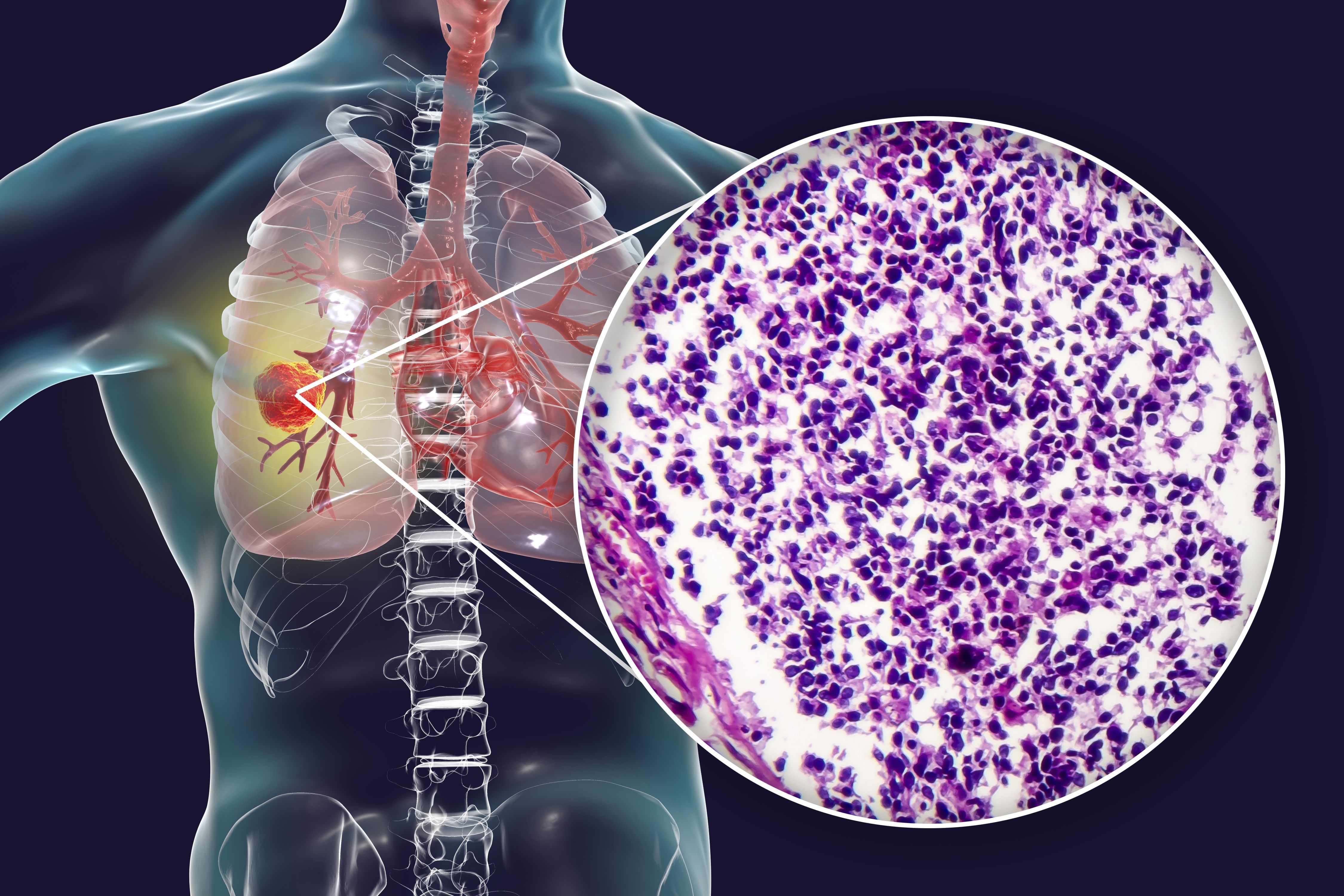Amivantamab Combo Shows Improved OS Trend Vs Osimertinib in EGFR+ NSCLC
Amivantamab/lazertinib also reduces the risk of second progression or death compared with osimertinib in the phase 3 MARIPOSA trial.
"There was a trend in overall survival that favored amivantamab plus lazertinib. Median survival was not reached, whereas it was 37.3 months in patients treated with osimertinib,” according to Shirish M. Gadgeel, MD.

A trend toward improved overall survival (OS) occurred when combining amivantamab-vmjw (Rybrevant) with lazertinib (Lazcluze) as frontline therapy vs osimertinib (Tagrisso) in those with advanced non–small cell lung cancer (NSCLC) harboring EGFR mutations, according to updated findings from the phase 3 MARIPOSA trial (NCT04487080) presented at the IASLC 2024 World Conference on Lung Cancer (WCLC).1
Specifically, the median OS via blinded independent central review (BICR) based on RECIST v1.1 criteria for amivantamab/lazertinib was not estimable (NE; 95% CI, NE-NE) compared with 37.3 months (95% CI, 32.5-NE) for osimertinib (HR, 0.77; 95% CI, 0.61-0.96; P = .019). At 3 years, 61% of patients on the amivantamab-lazertinib remained alive vs 53% of those on the osimertinib arm.
“There was a trend in [OS] that favored amivantamab plus lazertinib. Median survival was not reached, whereas it was 37.3 months in patients treated with osimertinib,” Shirish M. Gadgeel, MD, division head for hematology/oncology at Henry Ford Health, said during an oral presentation of the longer follow-up.
In the primary analysis of MARIPOSA, which was at a median follow-up of 22.0 months, amivantamab/lazertinib showed a significant improvement in progression-free survival (PFS) via BICR compared with osimertinib (HR, 0.70; 95% CI, 0.58-0.85; P<.001). An early interim OS analysis demonstrated a favorable trend for amivantamab/lazertinib vs osimertinib (HR, 0.80; 95% CI, 0.61-1.05; P=.11).
In August 2024, the FDA approved amivantamab combined with lazertinib for the first-line treatment of adult patients with locally advanced or metastatic NSCLC harboring EGFR exon 19 deletions or exon 21 L858R substitution mutations, as detected by an FDA-approved test.2 The approval was based on the primary MARISPOSA data.
In MARIPOSA, 1074 patients with treatment-naive, EGFR-mutated (with exon 19, exon 21, or L858R substitutions), locally advanced or metastatic NSCLC were randomly assigned 2:2:1 to open-label amivantamab plus lazertinib (n = 429), blinded osimertinib (n = 429), or blinded lazertinib (n = 216) to assess the contribution of components.
The primary end point was PFS based on BICR via RECIST v1.1 criteria; secondary end points included OS, intracranial PFS (icPFS), intracranial duration of response (icDoR), intracranial overall response rate (icORR), time to treatment discontinuation (TTD), time to subsequent therapy (TTST), and PFS2 (after first subsequent therapy).
At a median follow-up of 31.1 months and a data cutoff date of May 13, 2024, 185 of 421patients (44%) and 145 of 428 patients (34%) remained on treatment of amivantamab-lazertinib and osimertinib, respectively. A total 155 patients and 233 patients from the respective arms were determined to have investigator-assessed progressive disease, therefore discontinuing treatment.
At 3 years, a favorable trend in icPFS was shown in the amivantamab/lazertinib arm, with sustained and durable central nervous system (CNS) control. With a median follow-up of 31.1 months, the median icPFS was 24.9 months (95% CI, 20.1-34.7) and 22.2 months (95% CI, 18.4-26.1) in the amivantamab/lazertinib and osimertinib arms, respectively (HR, 0.82; 95% CI, 0.62-1.09; nominal P=.165). The 3-year landmark for icPFS was double for amivantamab/lazertinib (38%) compared with osimertinib (18%).
At the 31.1-month median follow-up of 31.1 months, the median icDoR was NE (95% CI, 21.4 months-NE) and 24.4 months (95% CI, 22.1-31.2) in the amivantamab/lazertinib and osimertinib arms, respectively. The icORR was 77% in both arms; however, amivantamab/lazertinib (95% CI, 70%-83%) demonstrated greater durability of response with improved icDoR vs osimertinib (95% CI, 71%-83%).
The median TTD was 26.3 months (95% CI, 22.3-30.4) and 22.6 months (95% CI, 20.3-24.5) from the amivantamab/lazertinib and osimertinib arms, respectively (HR, 0.80; 95% CI, 0.68-0.96; nominal P=.014). At 3 years, more patients from the amivantamab/lazertinib arm remained on treatment (40%) than in the osimertinib arm (29%).
Regarding TTST, the number of patients who experienced disease progression, discontinued treatment, and started subsequent therapy was similar between the 2 arms, at 72% with amivantamab/lazertinib and 74% with osimertinib. The median TTST was 30.0 months (95% CI, 20.3-36.0) with amivantamab/lazertinib and 24.0 months (95% CI, 22.5-20.2) with osimertinib (HR, 0.77; 95% CI, 0.65-0.93; P = .005). In both arms, the most common subsequent therapy after discontinuing study treatment was carboplatin/pemetrexed at 26% and 28%, respectively.
Additional findings showed that amivantamab/lazertinib significantly reduced the risk of second progression or death (PFS2) by 27%. The median PFS2 was NE (95% CI, 36.0-NE) and 32.4 months (95% CI, 29.3-NE) in the amivantamab/lazertinib and osimertinib arms, respectively (HR, 0.73; 95% CI, 0.59-0.91; P = .004). The 3-year landmark PFS2 rates were 57% and 49%, respectively.
“The MARIPOSA study is ongoing, and a prespecified final overall survival analysis with formal statistical testing will occur in the future. The FDA recently approved [the amivantamab/lazertinib] combination for the treatment of EGFR-mutant advanced non–small cell lung cancer for patients,” Gadgeel concluded.
References
- Gadgeel S, Cho BC, Lu S, et al. Amivantamab plus lazertinib vs osimertinib in first-line EGFR-mutant advanced NSCLC: longer follow-up of the MARIPOSA study. Presented at: \ IASLC 2024 World Conference on Lung Cancer; September 7-10, 2024; San Diego, CA. Abstract OA02.03.
- Rybrevant (amivantamab-vmjw) plus Lazcluze (lazertinib) approved in the U.S. as a first-line chemotherapy-free treatment for patients with EGFR-mutated advanced lung cancer. News release. Johnson & Johnson. August 20, 2024. Accessed August 20, 2024. https://www.investor.jnj.com/news/news-details/2024/RYBREVANT-amivantamab-vmjw-plus-LAZCLUZE-lazertinib-approved-in-the-U.S.-as-a-first-line-chemotherapy-free-treatment-for-patients-with-EGFR-mutated-advanced-lung-cancer/default.aspx
Newsletter
Stay up to date on recent advances in the multidisciplinary approach to cancer.